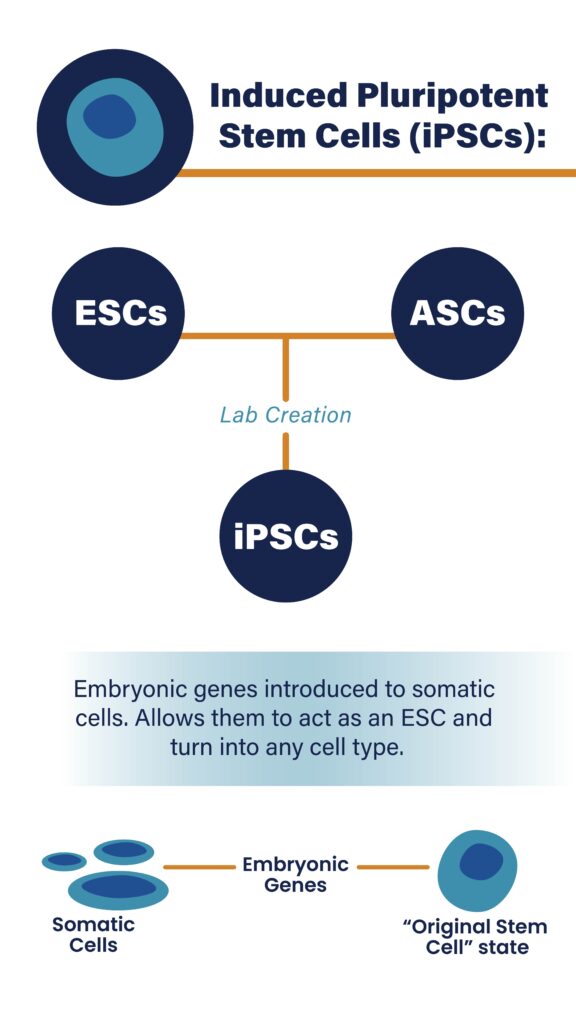Stem Cell Basics
Stem Cells are a hot topic in the medical field. Many medical researchers believe they can potentially treat a wide variety of diseases, including numerous rare diseases that currently have no treatment or cure. But, what is a stem cell, and is there just one type? We’re going to review what exactly a stem cell is and some of the different types researchers are exploring to find treatments for life-threatening diseases such as Duchenne muscular dystrophy (DMD).
What is a stem cell? Stem cells have the remarkable ability to develop into various specialized cell types within the body. They are the only cells in the body that have the ability to regenerate, allowing them to divide into either other stem cells, or specific cells like blood cells, brain cells, bone cells, and more. They play a crucial role in maintaining and repairing tissues throughout an individual’s life.
Stem cells are divided into three main categories based on their origin and developmental potential. It’s important to understand the distinctions between the different types of stem cells, as they each have unique properties.

These are found in the inner cell mass of the human blastocyst. This is in the early stage of embryo development and can last from 4-7 days after fertilization. In normal embryonic development, these stem cells disappear after the 7th day and start to form the three embryonic tissue layers. If these cells are extracted from the inner cells during the blastocyst stage they can be cultured in the laboratory, and under the right conditions can rapidly multiply forever. These cells are pluripotent, meaning they can turn into any type of cell in the body. Due to the versatility of these stem cells, researchers believe they will be useful to regenerate or repair diseased tissues and organs. However, they tend to form tumors after use, they are difficult to control, there are numerous ethical debates about using these cells, and there has not been a successful clinical trial using embryonic stem cells.CTFAC does not use or condone the use of ESCs for therapy.
These cells are found in lower quantities, and aren’t as versatile as Embryonic Stem Cells. While ESCs can transform into all cell types, ASCs are limited to transforming into distinct cell types based on their tissue of origin such as skin, heart, blood, brain, etc. The limited number of Adult stem cells makes it difficult to extract and study the cells for research purposes. There are five different types of Adult stem cells.
- Hematopoietic Stem Cells (Blood stem cells)
- Mesenchymal Stem Cells (MSCs)
- Neural Stem Cells
- Epithelial Stem Cells
- Skin Stem Cells


Induced Pluripotent Stem Cells (iPSCs):
These cells are a happy medium between embryonic and adult stem cells. They are created in a lab by introducing embryonic genes into a somatic cell that will cause it to revert to its “original stem cell” state. This allows them to act as an ESC and turn into any cell type.
How can stem cells help those affected by rare diseases? There is a need for alternative treatments for rare diseases, and while there is still a lot of research needed to fully understand the true ability to treat diseases like Duchenne muscular dystrophy, there are already numerous studies and success stories using MSCs. According to the National Library of Medicine, Mesenchymal Stem Cells have the ability to self-regenerate, differentiate into several cell lineages, and participate in immunomodulation, making them a promising tool to develop treatment strategies. Our founder, Ryan Benton, was the first person in the world with DMD to be successfully treated with MSC therapy. Unfortunately, the FDA regulations didn’t allow for that form of therapy in the U.S. so the majority of his treatments were received at the Stem Cell Institute in Panama City, Panama. After each treatment, Ryan felt significant improvements in his overall health and noticed a renewed strength, increase in stamina, and ease in his ability to breathe.
CTFAC is committed to seeing stem cell therapy using MSCs become the standard treatment for individuals living with DMD and other rare diseases and chronic conditions. We are working hard to help start the first clinical trial using Mesenchymal stem cell therapy for the treatment of DMD in the United States to help prove why this therapy should be approved for DMD and eventually a wide variety of diseases and conditions. We are committed to helping make stem cell therapy accessible and affordable for everyone battling rare diseases and chronic conditions.
Visit our website for more information on how you can help us improve the quality of life for those living with these conditions.
